The ASUS Maximus VIII Extreme Review: The Other $500 Option
by Ian Cutress on April 7, 2016 9:00 AM EST- Posted in
- Motherboards
- Gaming
- Asus
- ROG
- Skylake
- Z170
- Thunderbolt 3
Gaming Performance 2015
Our 2015 gaming results are still relatively new, but the issue of FCLK settings might play a big role here. At launch, the default setting for the communication buffer between the CPU and PCIe stack was 800 MHz, even though Intel suggested 1000 MHz, but this was because of firmware limitations from Intel. Since then, there is firmware to enable 1000 MHz, and most motherboard manufacturers have this - but it is unclear if the motherboard will default to 1000 MHz and it might vary from BIOS version to BIOS version. As we test at default settings, our numbers are only ever snapshots in time, but it leads to some interesting differences in discrete GPU performance.
Alien: Isolation
If first person survival mixed with horror is your sort of thing, then Alien: Isolation, based off of the Alien franchise, should be an interesting title. Developed by The Creative Assembly and released in October 2014, Alien: Isolation has won numerous awards from Game Of The Year to several top 10s/25s and Best Horror titles, ratcheting up over a million sales by February 2015. Alien: Isolation uses a custom built engine which includes dynamic sound effects and should be fully multi-core enabled.
For low end graphics, we test at 720p with Ultra settings, whereas for mid and high range graphics we bump this up to 1080p, taking the average frame rate as our marker with a scripted version of the built-in benchmark.
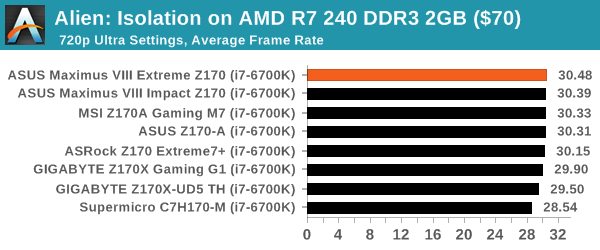
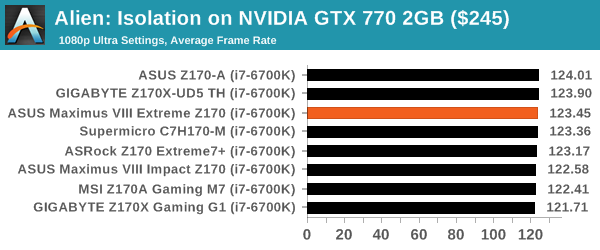
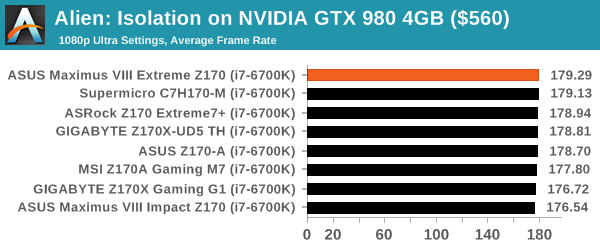
Total War: Attila
The Total War franchise moves on to Attila, another The Creative Assembly development, and is a stand-alone strategy title set in 395AD where the main story line lets the gamer take control of the leader of the Huns in order to conquer parts of the world. Graphically the game can render hundreds/thousands of units on screen at once, all with their individual actions and can put some of the big cards to task.
For low end graphics, we test at 720p with performance settings, recording the average frame rate. With mid and high range graphics, we test at 1080p with the quality setting. In both circumstances, unlimited video memory is enabled and the in-game scripted benchmark is used.
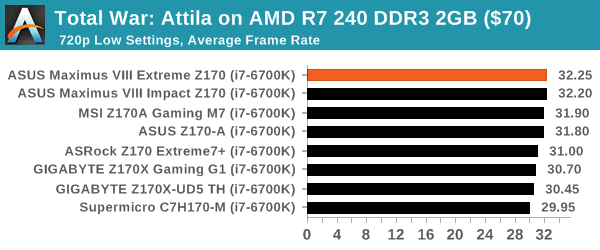
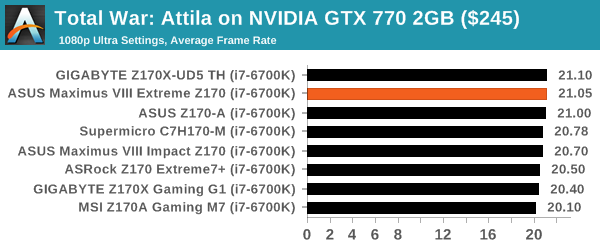
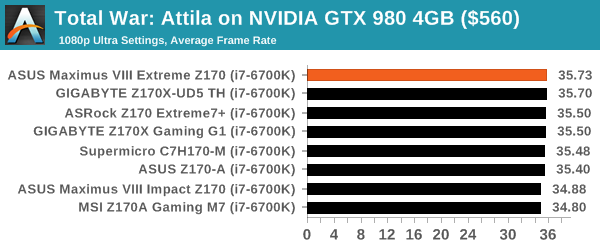
Grand Theft Auto V
The highly anticipated iteration of the Grand Theft Auto franchise finally hit the shelves on April 14th 2015, with both AMD and NVIDIA in tow to help optimize the title. GTA doesn’t provide graphical presets, but opens up the options to users and extends the boundaries by pushing even the hardest systems to the limit using Rockstar’s Advanced Game Engine. Whether the user is flying high in the mountains with long draw distances or dealing with assorted trash in the city, when cranked up to maximum it creates stunning visuals but hard work for both the CPU and the GPU.
For our test we have scripted a version of the in-game benchmark, relying only on the final part which combines a flight scene along with an in-city drive-by followed by a tanker explosion. For low end systems we test at 720p on the lowest settings, whereas mid and high end graphics play at 1080p with very high settings across the board. We record both the average frame rate and the percentage of frames under 60 FPS (16.6ms).
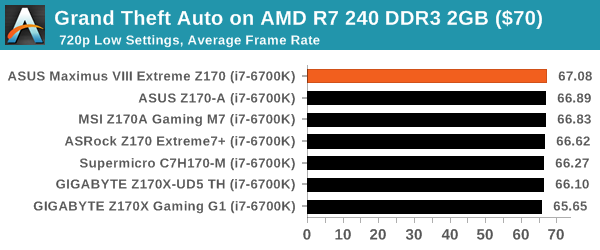
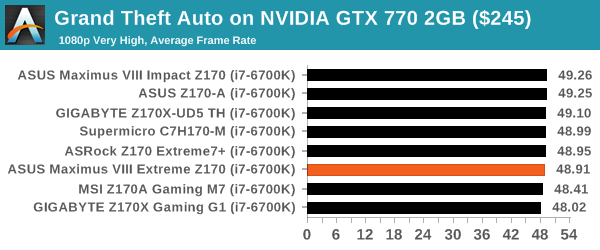

GRID: Autosport
No graphics tests are complete without some input from Codemasters and the EGO engine, which means for this round of testing we point towards GRID: Autosport, the next iteration in the GRID and racing genre. As with our previous racing testing, each update to the engine aims to add in effects, reflections, detail and realism, with Codemasters making ‘authenticity’ a main focal point for this version.
GRID’s benchmark mode is very flexible, and as a result we created a test race using a shortened version of the Red Bull Ring with twelve cars doing two laps. The car is focus starts last and is quite fast, but usually finishes second or third. For low end graphics we test at 1080p medium settings, whereas mid and high end graphics get the full 1080p maximum. Both the average and minimum frame rates are recorded.


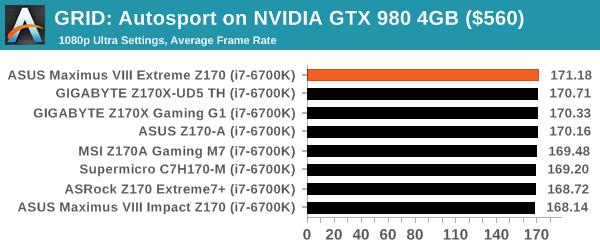
Middle-Earth: Shadow of Mordor
The final title in our testing is another battle of system performance with the open world action-adventure title, Shadow of Mordor. Produced by Monolith using the LithTech Jupiter EX engine and numerous detail add-ons, SoM goes for detail and complexity to a large extent, despite having to be cut down from the original plans. The main story itself was written by the same writer as Red Dead Redemption, and it received Zero Punctuation’s Game of The Year in 2014.
For testing purposes, SoM gives a dynamic screen resolution setting, allowing us to render at high resolutions that are then scaled down to the monitor. As a result, we get several tests using the in-game benchmark. For low end graphics we examine at 720p with low settings, whereas mid and high end graphics get 1080p Ultra. The top graphics test is also redone at 3840x2160, also with Ultra settings, and we also test two cards at 4K where possible.
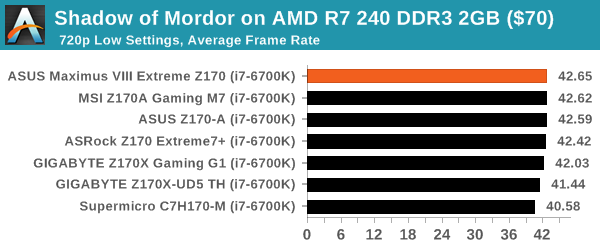
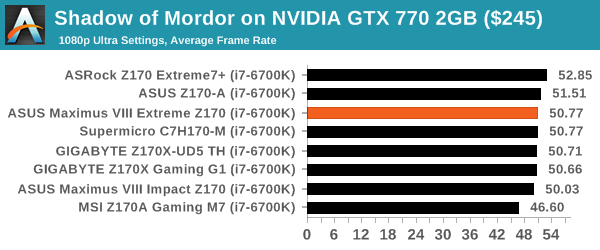

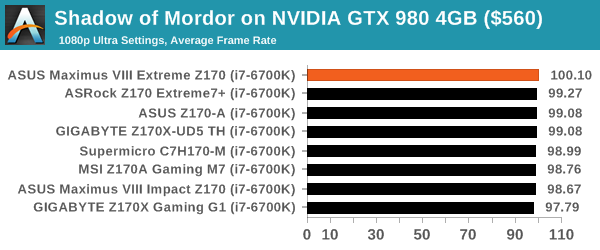
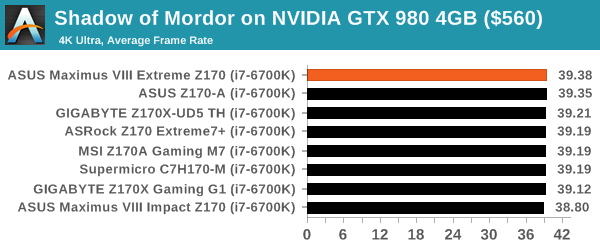















70 Comments
View All Comments
saratoga4 - Thursday, April 7, 2016 - link
>if you care about audio you're exiting it on hdmi anywayMaybe for speakers, but not headphones. Good headphone amps on receivers are surprisingly rare. HDMI replaces line out for a lot of people, which is why its unfortunate that reviewers typically test line out and ignore headphone out.
Impulses - Friday, April 8, 2016 - link
If you're only using headphones you can still do TOSlink out to an excellent outboard DAC/amp for $150-300 (less than an AVR) and it'll blow away anything that could be built into a mobo... Or just get a Xonar STX for $150, still pretty solid and the amp will still be better than anything on a mobo.jptech7 - Friday, April 8, 2016 - link
For headphone equipment, most are using USB audio or TOSLINK in my experience, but the idea is the same. I still respect the effort that Asus put into the audio system.Ubercake - Friday, April 8, 2016 - link
Even a $300 pro-level Asus board has exceptional on-board sound; better than many soundcards even in the $100-$150 range. In my opinion, the price on most sound cards is way too high, though the low demand due to people using great on-board sound might be the reason for the high price.Silma - Thursday, April 7, 2016 - link
This motherboard only makes sense for people who need low DPC latency, so mostly people in the audio/music industry.Otherwise the market is flooded with excellent 150 $ motherboards, which leave 350 $ to spend on a better graphic card, NVMe SSD, more memory or whatever makes sense for the user.
willis936 - Thursday, April 7, 2016 - link
Dude it's 2016.Dr. Swag - Thursday, April 7, 2016 - link
I know you guys are hard at work on all the different articles and reviews and I appreciate it, but just wondering where is the article you guys promised 2 months ago on a review and ipc analysis of the Athlon x4 845? I'm really looking forward to that since depending on how big of an improvement Excavator is it could also affect Zen (since AMD said Zen is Excavator+ 40% or more), and I'm super excited for Zen. It's been nearly 2 months, and I know the x4 845 wasn't out then but it's been on the market for at least a month now. Just curious on how far you guys are on that and if it is coming out soon.If you don't know what I'm talking about and somehow completely forgot about it, here is the link to the original comment:
http://www.anandtech.com/comments/10000/who-contro...
ghanz - Thursday, April 7, 2016 - link
Seconded.extide - Thursday, April 7, 2016 - link
On page one, the Motherboard Comparison table is all screwed up. If you pick Asrock Z170 Extreme 7+, you get the stats for the MSI Gaming M7. If you pick the MSI Gaming M7, you get the stats of something else. If you pick the Asus Z170A you get the stats for the Asrock Extreme 7+. Please fix!extide - Thursday, April 7, 2016 - link
I am sure they are all messed up, those are only the ones I knew were wrong off the top of my head.